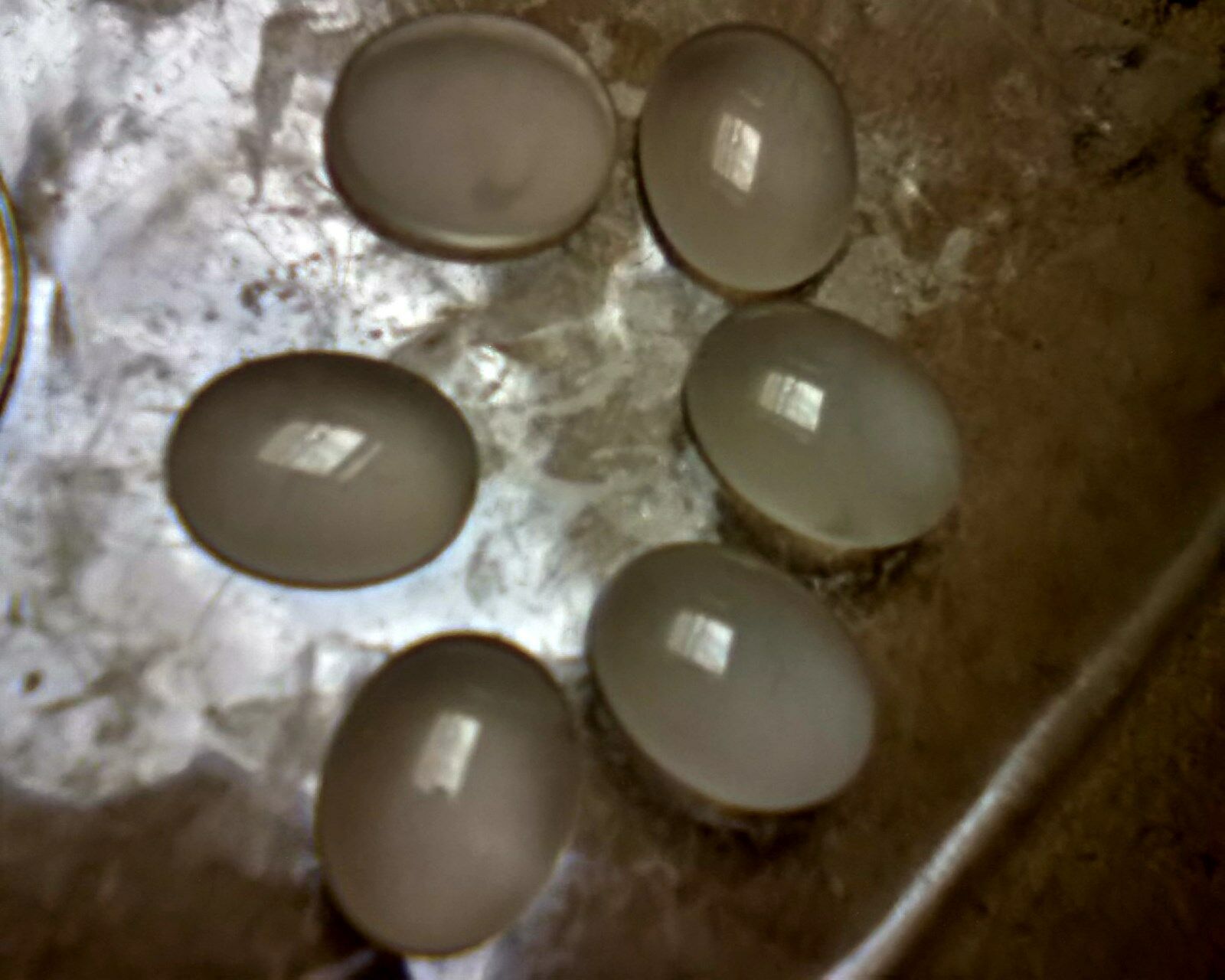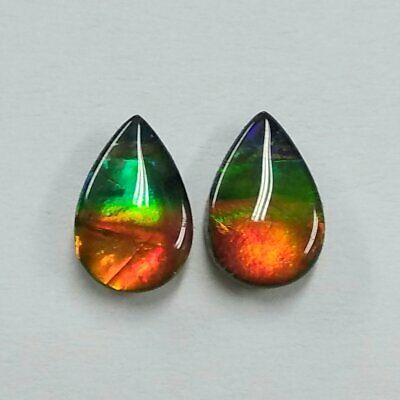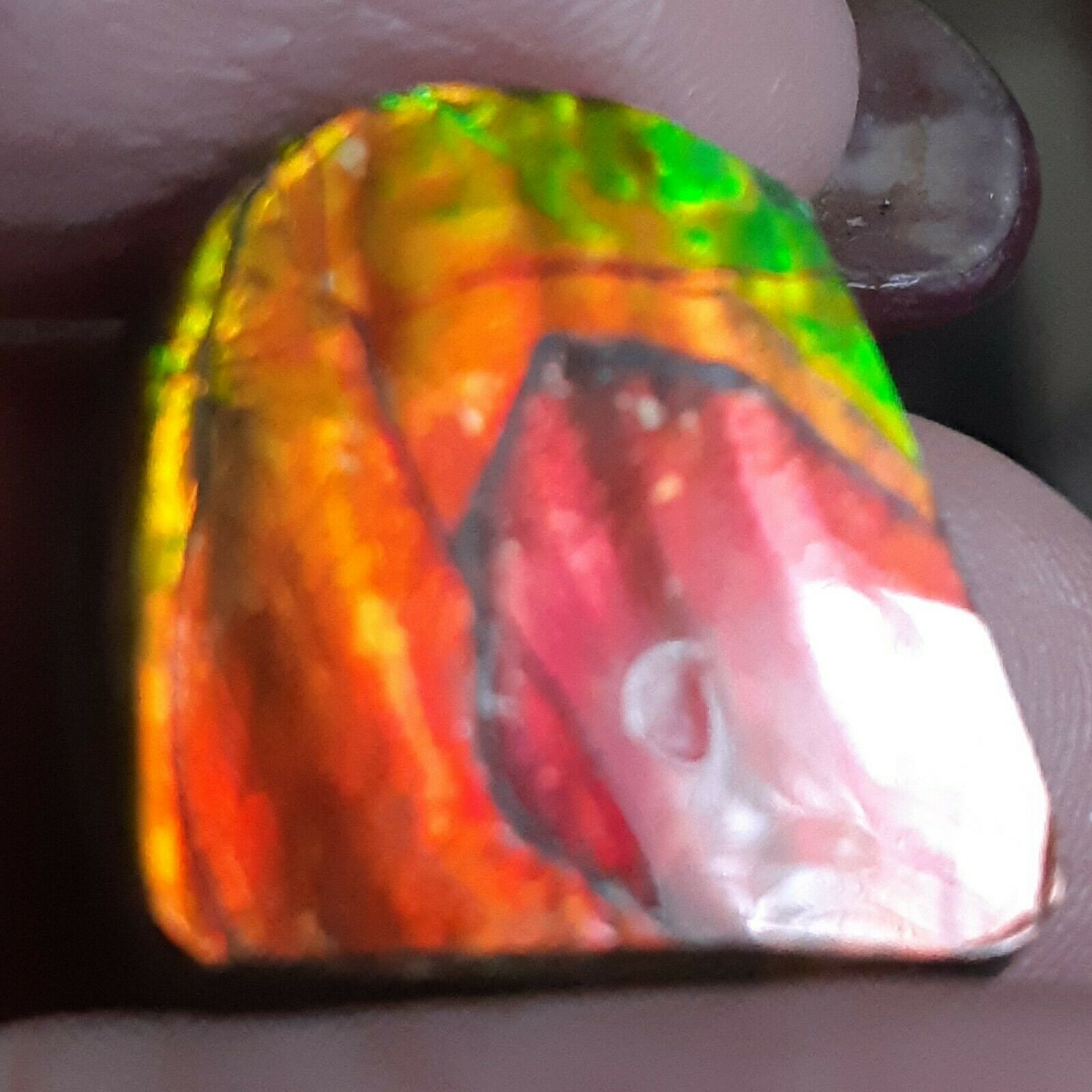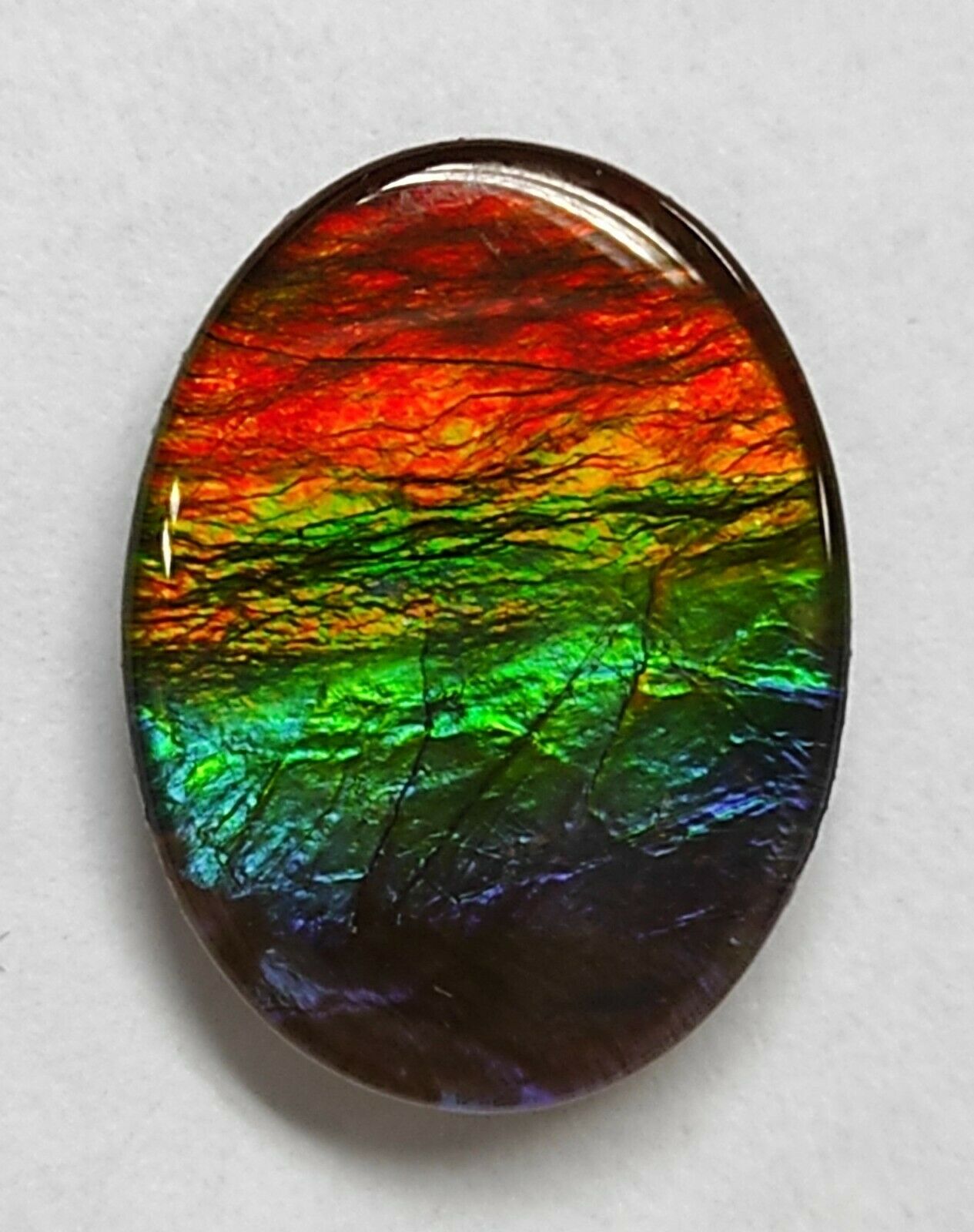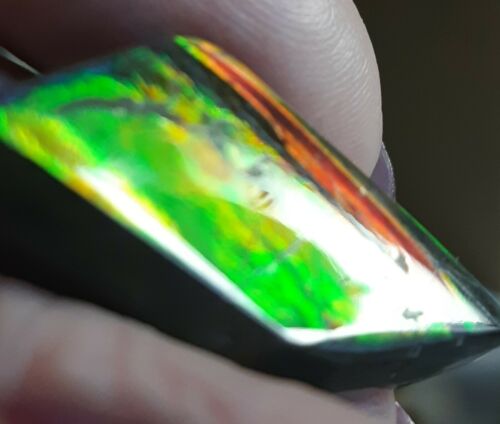-40%
GEM AMMOLITE on AMMONITE*Dragon Skin*805 carats*109 mm or 4 3/8 inches*CANADA
$ 224.4
- Description
- Size Guide
Description
"Ammolite is revered by Feng Shui masters as the most influential stone of the Millennium. It is believed anyone possessing Ammolite is entitled to wondrous prosperity and fortune."BEAUTIFUL specimen of Gem Ammolite on a section of Fossil Ammonite is 71.3 Million Years old, Cretaceous Age, from the Bearpaw Formation, Alberta, Canada. The scientific name for the type of Fossil Ammonite is Placenticeras meeki. Ammolite became an official gemstone in 1981! This piece is much more beautiful than TEN photos! Surface is coated with a protective coating with a high lustre. The natural cracked surface revealed in the photos is shown beneath the clear layer of protection and photos make it look much rougher than it is. Surface is very smooth to the touch. This is a VERY colorful specimen, with ORANGE and GREEN as dominant colors. It was difficult to capture the magnificence of the various orange colors that appear when held in a certain direction. This type of structure on the Fossil Ammolite is often called Dragon Skin and is highly desirable. Please read all about the fossilization, history, mining, scientific and metaphysical properties of GEM AMMOLITE, below. Beautiful Ammolite specimen MEASURES 109 millimeters long X 56 mm wide X a maximum of 14 mm thick OR 4 3/8 inches long X 2 1/4 inches wide X maximum of over 1/2 inch thick. Ammolite specimen on section of Fossil Ammonite WEIGHS 161 grams OR 805 carats OR 5.68 ounces. *International Buyers please note that an additional insurance charge will apply as normal Priority Mail International just includes up to 0 insurance. International buyers please message me for EXACT shipping charge and options.
HISTORY AND SCIENCE OF AMMOLITE
Ammolite is an opal-like organic gemstone found primarily along the eastern slopes of the Rocky Mountains of North America. It is made of the fossilized shells of ammonites, which in turn are composed primarily of aragonite, the same mineral contained in nacre, with a microstructure inherited from the shell. It is one of few biogenic gemstones; others include amber and pearl. In 1981, ammolite was given official gemstone status by the World Jewellery Confederation (CIBJO), the same year commercial mining of ammolite began. It was designated the official gemstone of the City of Lethbridge, Alberta in 2007.
Ammolite is also known as aapoak (Kainah for "small, crawling stone"), gem ammonite, calcentine, and Korite. The latter is a trade name given to the gemstone by the Alberta-based mining company Korite. Marcel Charbonneau and his business partner Mike Berisoff were the first to create commercial doublets of the gem in 1967. They went on to form Ammolite Minerals Ltd.
An iridescent opal-like play of color is shown in fine specimens, mostly in shades of green and red; all the spectral colors are possible, however. The iridescence is due to the microstructure of the aragonite: unlike most other gems, whose colors come from light absorption, the iridescent color of ammolite comes from interference with the light that rebounds from stacked layers of thin platelets that make up the aragonite. The thicker the layers, the more reds and greens are produced; the thinner the layers, the more blues and violets predominate. Reds and greens are the most commonly seen colors, owing to the greater fragility of the finer layers responsible for the blues. When freshly quarried, these colors are not especially dramatic; the material requires polishing and possibly other treatments in order to reveal the colors' full potential.
The ammolite itself is actually a very thin sheet, ca. 0.5–0.8 millimeters (0.02–0.03 inches) in thickness. Rarely is ammolite without its matrix, which is typically a grey to brown shale, chalky clay, or limestone. So-called "frost shattering" is common; exposed to the elements and compressed by sediments, the thin ammolite tends to crack and flake; prolonged exposure to sunlight can also lead to bleaching. The cracking results in a tessellated appearance, sometimes described as a "dragon skin" or "stained glass window" pattern. Ammolite mined from deeper deposits may be entirely smooth or with a rippled surface. Occasionally a complete ammonite shell is recovered with its structure well-preserved: fine, convoluted lines delineate the shell chambers, and the overall shape is suggestive of a nautilus. While these shells may be as large as 90 centimeters (35.5 inches) in diameter, the iridescent ammonites (as opposed to the pyritized variety) are typically much smaller. Most fossilized shells have had their aragonite pseudomorphously replaced by calcite or pyrite, making the presence of ammolite particularly uncommon.
WHAT FOSSILS ARE AMMOLITE FROM AND WHERE ARE THEY FOUND?
Ammolite comes from the fossil shells of the Upper Cretaceous disk-shaped ammonites Placenticeras meeki and Placenticeras intercalare, and (to a lesser degree) the cylindrical baculite, Baculites compressus. Ammonites were cephalopods, that thrived in tropical seas until becoming extinct along with the dinosaurs at the end of the Mesozoic era.
The ammonites that form ammolite inhabited a prehistoric, inland subtropical sea that bordered the Rocky Mountains—this area is known today as the Cretaceous or Western Interior Seaway. As the ammonites died, they sank to the bottom and were buried by layers of bentonitic mud that eventually became shale. Many gem-quality ammonites are found within siderite concretions. These sediments preserved the aragonite of the shells, preventing it from converting to calcite.
Significant deposits of gem-quality ammolite are only found in the Bearpaw Formation that extends from Alberta to Saskatchewan in Canada and south to Montana in the USA. However, small deposits have been found as far south as Central Utah which also contains gem-quality ammolite. The best grade of gem quality ammolite is along high energy river systems on the eastern slopes of the Rockies in southern Alberta. Most commercial mining operations have been conducted along the banks of the St. Mary River, in an area south of and between the town of Magrath and the city of Lethbridge. Roughly half of all ammolite deposits are contained within the Kainah (Kainaiwa) reserve, and its inhabitants play a major role in ammolite mining. Since its founding in 1979, Korite has operated primarily within the reservation. The company had an agreement with the Kainah (Blood) tribe, with Korite paying the tribe royalties based on how much land the company has mined. This agreement has expired. It prohibited the Blood Tribe members from surface mining along the banks and cliffs of the St. Mary River. There were about 35 licensed Blood surface miners in 2018. The surface miners are self employed mining in all kinds of weather. Some miners also restore the fossils they find or resell their finds to other fabricators.
MINING OF AMMOLITE
Commercial extraction is mechanized but fairly basic: shallow open pits are dug with a backhoe and the excavated material is screened for its potential gem contents. The pits are further examined by hand, and commercial production is supplemented by individuals who sell their surface-picked findings to Korite and several other producers. Approximately 50% of the ammolite mined is suitable for jewelry. Korite, the largest miner of ammolite, produces over 90% of the world's supply. As of 2015, Korite has mined over 100 acres of ammolite deposits. The company employs over 280 people and accounts for approximately 90 percent of world gem ammolite production.
MINERALOGY OF ARAGONITE composing AMMOLITE
Color: Green, Blue, Red, Violet, Yellow, Orange, Indigo
Luster: Vitreous
Crystal system: Orthorhombic crystal system
Chemical formula: CaCO₃
Hardness (Mohs hardness scale): 3.5 – 4
Transparency: Translucent, Transparent
The chemical composition of ammolite is variable, and aside from Aragonite may include calcite, silica, pyrite, or other minerals. The shell itself may contain a number of trace elements, including: aluminium; barium; chromium; copper; iron; magnesium; manganese; strontium; titanium; and vanadium. Its crystallography is orthorhombic. Its hardness is 3.5–4.5, and its specific gravity is 2.60–2.85. The refractive index of Canadian material (as measured via sodium light, 589.3 nm) is as follows: α 1.522; β 1.672–1.673; γ 1.676–1.679; biaxial negative. Under ultraviolet light, ammolite may fluoresce a mustard yellow.
METAPHYSICAL PROPERTIES OF GEM AMMOLITE
Keywords: Prosperity, well-being, improving flow of energy, elemental power, longevity
Ammolite Crystal Healing Properties:
Ammolites are a high vibration crystal believed to help activate both the etheric and physical DNA, awakening our awareness to the “perfect” human state, in order to bring about evolutionary shifts in consciousness. Ammolites carry the full spectrum of colours of the first 7 chakras and the shell is in the form of a spiral, chakra energy flows in a spiral and so they can be used to improve the flow of energy or chi and transform negative energy into positive energy. Ammolites can increase stamina, relieve trauma and be used in meditation to connect with past lives. They are stones of luck, prosperity and well being, helping to alleviate depression and exhaustion.
Ammolite Uses:
In the tradition of Feng Shui it is called the Seven Colour Prosperity Stone, the beautiful iridescent colours of Ammolite in all the shades of the rainbow, represent the harmonious balance of fire, earth, metal, water, and wood. It is believed that the Ammolite absorbed all the knowledge of the universe, and is therefore able to enhance wisdom, increase wealth and improve the flow of chi. Placed in the home it is said to transform negative energy, bring harmony and increase the vitality of the occupants and their visitors. The Blackfoot Indians refer to it as Buffalo Stone because it brought luck to the wearer during the buffalo hunt.
Care instructions: Ammolite, being an organic gemstone, requires extra care; do not use a commercial cleaning solution or ultrasonic cleaner and don’t leave it soaking in liquid. Keep it away from perfumes, hairspray and household chemicals.










